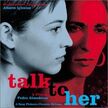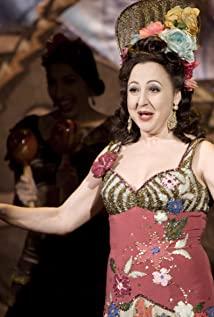For the first time, I just remember being moved, and then I look at it again so that I can get away from myself a little and try to look objectively.
1. The plot of the side Yi obliquely
As far as story itself is concerned, of course, what is impressive is the love between Vasino and Asimoline. This is a bit of a one-sided love like "Letter from a Strange Woman", so sincere that the director himself is not sure if it has the courage to face the sun.
If Asimoline's awakening, and the healthy birth of a child, was a response to Vasino's consistent care and confidence, then Vasino's death was inevitable when Asimoline woke up, because this Apparently it's a love that hasn't been recognized yet.
In addition to Vasino's love, another clue in "Tell Her", the reporter Mark's love, what did it say, what does it have to do with Vasino's love?
Mark originally thought that Julia loved him. She thought that Julia, who was crying in the church, was thinking of him. She never thought that Julia still thought about her ex-husband. She cried because she missed her ex-husband.
Mark was vague when he talked to Vasino and Julia about his wife. Mark sheds tears thinking of his ex-wife, Julia said that she envied his ex-wife, and she meant that it would be nice if her ex-husband was with her, like Mark and his ex-wife.
Mark and ex-wife and Mark and Julia, Julia and ex-husband, their relationship is not equal. Love always hurts and separates because of imbalance. And Vasino's love was completely identical because of Asimoline's coma.
This contrast, shocking the viewer, is obviously not as strong as Vasino's pure love and Vasino's death, but it is enough to sublimate a story into a feeling.
If only tell the story of Vasino? From the screenwriter's point of view, not only is it easy to appear monotonous, but there is no way to delay the speed of the story, and there is no way to lay out different layers to finally reach a climax.
However, the main reason is that Almodovar has always refused to be pure. He always tells a story through a story, an emotion that covers the whole situation.
The complexity of this emotion is obviously beyond the scope of a story. Side Yi slanted out, which is his means of dyeing his emotions. Everything in "Tell Her" except for Vasino's love belongs to the part where Pang Yi slants out.
However, aren't the trees and flowers swaying colorfully because they slanted out?
2. Play within a play
Almodovar 's films often feature a play within a play. In "Tell Her", there are two kinds of play within play.
The first category is the dance at the beginning and end. In the dance at the beginning, the dancers are sad and desperate, as if struggling and rushing in the dark. The stage, originally full of tables and chairs, was randomly pushed open by the theater manager according to the direction of the actors' movements, becoming the channel for the actors. When the actor hit a wall in front of the wall, his body fell stiffly, got up, and continued to struggle on the stage. Is he talking about the hesitation, despair, and sadness in his heart?
The dance at the end is also very special. In the first act, along with the music, a pair of actors and actresses appeared from behind the scenes, and their movements were mechanical and neat, as if an electric door was slowly unfolding. Afterwards, the actors dispersed, leaving a pair of actors. The stage setting is a real green gable. The actors switch between realism and concepts, expressing the process of depression, confusion and pursuit in form.
After the intermission, in the second act, the actress, held up by the actor's hand, gasps from time to time to the rhythm of the music. The actress lifted up in parallel, with a stiff figure, reminiscent of a corpse. And the gasp in music, or expresses the pressure that people can't bear.
In these two scenes, the music is pathetic and the dance takes on a similar form. The expressions of the actors are in a state of absolute self. Therefore, the performativeness is reflected in the self, rather than at the level of the audience, and has a sincere power from the heart.
The second type of play-in-play is the silent film "Shrinking Lover". Silent films are Asimoline's favorite, and Vasino saw it because of Asimoline. And because of the sexual depiction in this film, he made an act that caused the story to turn sharply.
In order to pave the way for Vasino's behavior, the director showed silent films for a long time. Wassino watched silent films because of his love, and because watching silent films stimulated Wassino's behavior towards Asimoline, the result was the destruction of his love.
Among them, the first type of stage play, in addition to controlling the atmosphere of the audience, also takes into account the narrative function. First, Vasino and Mark used to sit next to each other in the theater; second, Vasino went to the dance play because of Asimoline; third, Mark's sentimentality was the externalization of the director's heart, who was responsible for integrating dance and film. The function of externalizing the whole feeling of the whole; Fourth, Mark finally meets Acimoline in the theater.
The first three functions are basically clear, and the last one, I don't quite understand what the director meant. According to the description in the movie, it is estimated that Mark and Asimoline will meet in the future. Then, there will be love between them or just for Mark to tell the truth to Asimoline one day. What does this have to do with Vasino's love? Relationship, what does it have to do with balance and imbalance in love?
3. Obsessive music In addition to
dance , music is also an important element of "Tell Her".
As the screenwriter's bible "Story" says, using a voiceover is the dumbest way to do it. Music can be good or bad if there is a voiceover. If the narrative function of music makes one go beyond the picture and only hear the music, I don't think McKee's statement is entirely arbitrary.
In the scene of singing in the courtyard, the story directly draws on the power of the music itself. But, as with the stage play, there is a scene that makes it possible, so it is not obtrusive.
Thinking about it carefully, the biggest problem of the voice-over is that it breaks the original illusion of reality, so that the audience can leave the scene and observe the movie outside the incident, instead of making the audience believe it as before.
If the director's purpose is to be lyrical here, that's fine. Or like the two games mentioned above, there is a clear reason, no problem.
Once the off-screen music becomes something that is always present and keeps the viewer's emotions in a state of tension for a long time, the viewer will examine whether the music is appropriate and whether it causes compulsion.
I think the music in "Tell Her" sometimes feels a little too much, probably because Almodovar is a little too hard.
Checked the information, it is "Cucurrucucu Paloma" by Caetano Veloso, and it is said that Wong Kar-wai's "Splendid Spring" also uses this song.
As far as I know about music (not at all), I only remember the waterfall section in "Spring Comes Together". The music, the waterfall and the protagonist's emotions echo each other, which seems to be more intense.
Either because of the waterfall, or because of the emotional foreshadowing in the movie. In "Tell Her", it is obviously more tactful.
I don't know if Luo Zhanfeng has an article on "Tell Her".
View more about Talk to Her reviews











